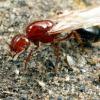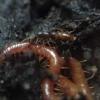lol I used your link. And yes, Monomorium are small but when it comes to the node shape, Monomorium are the closest resemblance I saw.
I thought the node shaped looked just like Monomorium as well, but at that size, it's clearly not Monomorium.
If it wasn't for the size and the nest structure, I would probably guess these are Pheidole xerophila.
Do they look anything like these?


















